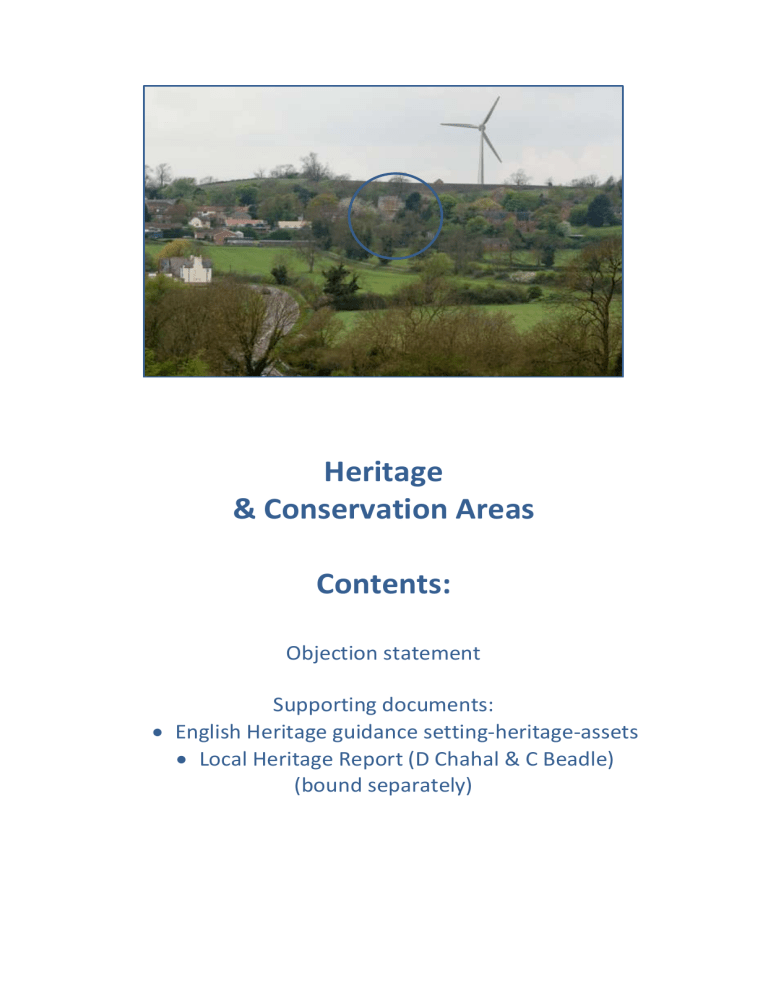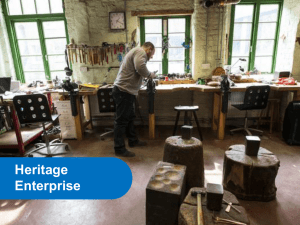Heritage & Conservation Areas

Heritage
& Conservation Areas
Contents:
Supporting documents:
English Heritage guidance setting-heritage-assets
Local Heritage Report (D Chahal & C Beadle)
(bound separately)
Objection statement
Introduction.
The proposed turbine site is located at the heart of a rich and varied heritage landscape:
Upper Broughton and Hickling are both conservation villages
Within a 5,000 metre (5km) radius of the turbine site the applicant has identified 140 designated heritage assets; an indication of the richness of the heritage environment.
The Churches of Upper Broughton and Hickling are both grade 1 listed and the church of Nether Broughton is grade 2 listed.
A significant number of these properties & assets will be in view of the turbine (either to or from) and the turbine will form part of the wider view encompassing all of these properties (both for residents and for people moving through the area).
Listed properties such as Dell farm on Green Lane and White House in Upper
Broughton are within approx. 600m of the proposed site and will be affected by the full visual impact of the development
(photographs in separate Visualisations document & below)
(English Heritage Guidance notes are attached, giving details of definitions and considerations when planning developments within a heritage setting. See also, Planning
Policy References section for the relevant planning guidance for heritage issues.)
Natural England:
“The landscape that we see today is a product of its historical evolution, reflecting the underlying physical resource and the changing nature of human exploitation of the land. The landscape will, of course, continue to change and evolve, reflecting the changing priorities and demands that society places on it. Over recent decades, however, these priorities and demands have often degraded rather than improved the fabric of the landscape. There is now a general consensus that positive action is needed to reverse this trend, and that this should place a high value on conserving and enhancing the inherent character and diversity of our landscapes.”
“Cultural heritage is evident in the Trent and Belvoir Vales NCA with the overall settlement pattern little changed since medieval times.”
“… the area’s villages are generally small with a finely balanced historic character that could be affected by even small amounts of inappropriate development.” (Leics
& Notts Wolds NCA)
The heritage landscape is overwhelmingly rural in character and horizontal in scale with the highest buildings tending to be local Churches with Belvoir Castle visible in the distance.
The degree to which an industrial structure on this scale and sited at the summit of
Belvoir Ridge would intrude on the overall landscape is explained in more detail in the landscape section.
However, an extremely significant characteristic of this landscape and one of the main reasons that it should be protected, relates to its heritage characteristics; a rural/farmed countryside and settlements which have evolved harmoniously over centuries and certainly since mediaeval times:
(Natural England): “Red brick buildings with pantile roofs are widespread and most abundant clustered around churches, which are constructed from ironstone and limestone contributing to the local vernacular.”
It is the combination of designated and non-designated heritage assets which continue to exist within an environment retaining its overall landscape and heritage integrity which is of most significance when considering the impact of a new and dominant industrial structure
on a prominent site and visible for such extended distances.
The impact on individual highly significant heritage sites is extremely important
But of greater significance is the undermining nature of this proposal on the overall, wider character of the heritage landscape which exists around these individual sites and provides an on-going valuable setting that should be preserved and actively protected.
It is for this reason that we would urge you to refuse the current application.
(cont’d overleaf)
An example:
A striking example of the heritage links across and within this landscape can be seen in the relationship between the churches of St. Luke’s Upper Broughton and, across a small valley,
St. Mary’s Nether Broughton.
Both built in traditional local materials and small in scale, they have looked across at each other for centuries, linking the two communities on the same East to West line and characterising the heritage of the area in a way that words don’t do justice to:
Photographs showing the Old Rectory and St. Mary’s Nether Broughton (to the left of the
Old Rectory and partially behind the trees during summer months) taken from the garden of a house neighbouring Upper Broughton Church (pictured at the end of the sequence).
From the other direction, photographs have been taken from the garden of the Old Rectory and from the churchyard in Nether Broughton:
If approved, the turbine will become a third landmark in line with these two beautiful churches and representing an over-powering industrial presence within this beautiful and centuries old setting.
Attached in a separate folder is a Heritage Report compiled by local
historians Mrs D Chahal and Mrs C Beadle:
1.
Refers to specific issues arising from the applicant’s heritage report and planning statement but also includes an overview of the heritage of the locality
2.
Appendices; additional information and photographs exploring the heritage of the locality in more detail.
Planning Guidance.
National Planning Policy Framework:
(p6) “conserve heritage assets in a manner appropriate to their significance, so that they can be enjoyed for their contribution to the quality of life of this and future generations;”
(p30) “a positive strategy for the conservation and enjoyment of the historic environment … In doing so, they should recognise that heritage assets are an irreplaceable resource and conserve them in a manner appropriate to their significance” o The impacted landscape is a rich heritage environment with a centuries-old vernacular maintain its integrity through to modern times.
(p31) “The effect of an application on the significance of a non-designated heritage
asset should be taken into account in determining the application. In weighing applications that affect directly or indirectly non designated heritage assets, a balanced judgement will be required having regard to the scale of any harm or loss and the significance of the heritage asset.” o Although there are significant heritage assets impacted in their own right, the heritage character of the wider area is also of high significance; within this non-designated heritage assets contribute to this overall character. Of particular interest are two houses neighbouring the proposed site; High
Holborn and Sycamore Lodge, both sensitively and extensively renovated to preserve their original integrity.
Rushcliffe Local Plan (pt2 Environment):
2.8. “In considering planning applications the Borough Council will pay special attention to the desirability of preserving or enhancing the character or appearance of the conservation area as required by the Planning (Listed Building and Conservation Area) Act 1990. The character of different areas and sites may need different consideration. PPG 15 states
"Special regard should be had for such matters as scale, height, form, massing, respect for the traditional pattern of frontages, vertical or horizontal emphasis, and detailed design."” o The character and appearance of the affected conservation areas are of particular concern in the context of the industrial nature and huge vertical scale of the proposed turbine.
2.8.EN2: “PLANNING PERMISSION FOR DEVELOPMENT INCLUDING … WITHIN A DESIGNATED
CONSERVATION AREA, OR OUTSIDE OF BUT AFFECTING ITS SETTING, OR VIEWS INTO OR
OUT OF THE CONSERVATION AREA WILL ONLY BE GRANTED WHERE: a) THE PROPOSAL WOULD PRESERVE OR ENHANCE THE CHARACTER OR APPEARANCE OF
THE CONSERVATION AREA BY VIRTUE OF ITS USE, DESIGN, SCALE, SITING AND MATERIALS; o The proposed turbine is not in keeping with the existing character of views from and towards the affected conservation areas and its industrial nature is not of a style which would enhance this character.
2.14. EN4: PROPOSALS FOR DEVELOPMENT AFFECTING THE SETTING OF A LISTED
BUILDING, WILL ONLY BE PERMITTED WHERE THEY ARE ACCEPTABLE IN TERMS OF SCALE,
MASSING, FORM, SITING, DESIGN AND MATERIALS.
o The proposed turbine is not in keeping with the existing character of settings affecting listed buildings and its industrial nature is not of a style or scale which would enhance this character.
2.16. “PPG 16 makes clear that the desirability of preserving an ancient monument and its setting is a material consideration in determining planning applications, whether the monument is scheduled or unscheduled. Government guidance in PPG16 indicates that development that would affect an Scheduled Ancient Monument or other significant archaeological remains should be considered very carefully in order to protect the nations cultural heritage. Such sites are part of the heritage of Rushcliffe and are important not only for their own sake, but also for education, tourism and leisure purposes. The Borough
Council is therefore keen to protect such sites from development.”
2.17. “Development affecting scheduled Ancient Monuments and their settings will be subject not only to planning approval, but also to Scheduled Ancient Monument Consent, which is administered directly by the Secretary of State. The Borough Council will not grant planning permission for any proposal which would detrimentally affect scheduled Ancient
Monuments and their settings.” o 2.16 & 2.17 are relevant because the wider setting of a range of scheduled monuments will be affected by a change of character in the area brought about the industrialisation & potential proliferation associated with this wind turbine application; added consequence is attached to the potential for devaluing an area with an established visitor and tourist profile.
EN6 – ANCIENT MONUMENTS
PERMISSION WILL NOT BE GRANTED FOR DEVELOPMENT WHICH WOULD DESTROY OR
DETRIMENTALLY AFFECT SCHEDULED ANCIENT MONUMENTS OR THEIR SETTINGS.









